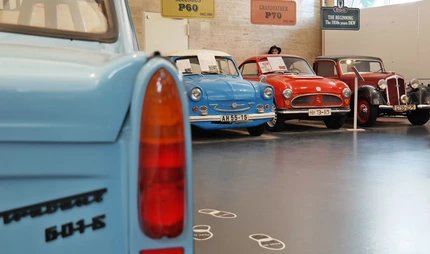
Museum of Silence (Museum der Stille)
Reflection through art
Come to yourself in the meditative rooms of the Museum of Silence. Simply take your time and let the works of art by Nikolai Makarov take effect on you.
The Museum of Silence is possibly one of the most extraordinary museums in Berlin. It was conceived by the Russian painter Nikolai Makarov as an oasis of tranquillity in the heart of the eternally busy district of Berlin-Mitte. On arrival, you find yourself standing in front of a Wilhelminian style house. You cannot look in as the windows are covered for privacy. On entering the building, find yourself in rooms with earthy red walls and ceilings. Sound-absorbing carpets swallow all noise. You are alone in silence – and with works of art.
The feeling of the here and now
Nikolai Makarov's paintings look almost transparent and calm. Looking at them you can feel relaxed, as if there were only the here and now, nothing else. Founded by Makarov, the Museum of Silence is inspired by the famous Mark Rothko Chapel in Houston. Contemplation, calm, meditation, reflection, silence and depth - all these moods arise in you when you spend time here. This is a good alternative to stress and inner tension. For Makarov himself, it offers a feeling of infinity. In the first room, see white platforms with seven architectural models: ideas for further places of silence by architects like Stephan Braunfels, Michael Marshall and Franco Stella. Sergei Tchoban, for example, imagines a completely round room which looks lit like a crystal ball. Maybe you will be able to enter these unusual places soon. Go further into the heart of the museum - the Space of Silence. Here the artist displays only one picture: an abstract landscape in grisaille technique. In front of this painting, which occupies the whole wall, stands a simple wooden bench. The light is dimmed which evokes shadows that become part of the artwork.
Features of the Museum of Silence
- Nikolai Makarov's painting in grisaille technique.
- Architectural models of possible future spaces of silence.
- Rooms in meditative earthy red colour.
- Soothing light.
- Silence.
Art in the vicinity
It is a 300 metre walk from the Museum of Silence to the KW Institute for Contemporary Art. The art historian and cultural manager Klaus Biesenbach founded the gallery in the 1990s, in a former margarine factory. The museum showcases the latest trends of the world's contemporary art scene with changing exhibitions. Commissioned works are created in workshops here where artists experiment with new styles. In 1996, the KW launched the Berlin Biennial for Contemporary Art, now a cultural centrepiece. Since 1969, the nbk Neuer Berliner Kunstverein has also devoted itself to modern art. It is a ten minute walk from the Museum of Silence to nbk in Chausseestraße. Young artists from Berlin in particular exhibit in the rooms of the Kunstverein, including students and scholarship holders. A special feature is the Artothek – art to take away. Here you can borrow one of the 4,000 art works for your living room wall for up to six months. In addition, there is a collection of international video art of all genres. With over 1,600 works, it is one of the largest in Germany. Well-known artists of the Artothek's early phase are Bruce Naumann and Nam June Paik.
Recommendations for your visit
The Museum der Stille can easily be reached by public transport. Take the U6 underground to the Oranienburger Tor stop. Alternatively, take the S-Bahn S1, S2 or S25 to Oranienburger Straße. From both stations you walk only about 15 minutes on foot. For drivers, the car park in Luisenstrasse is closest. Entrance to the museum is free.



